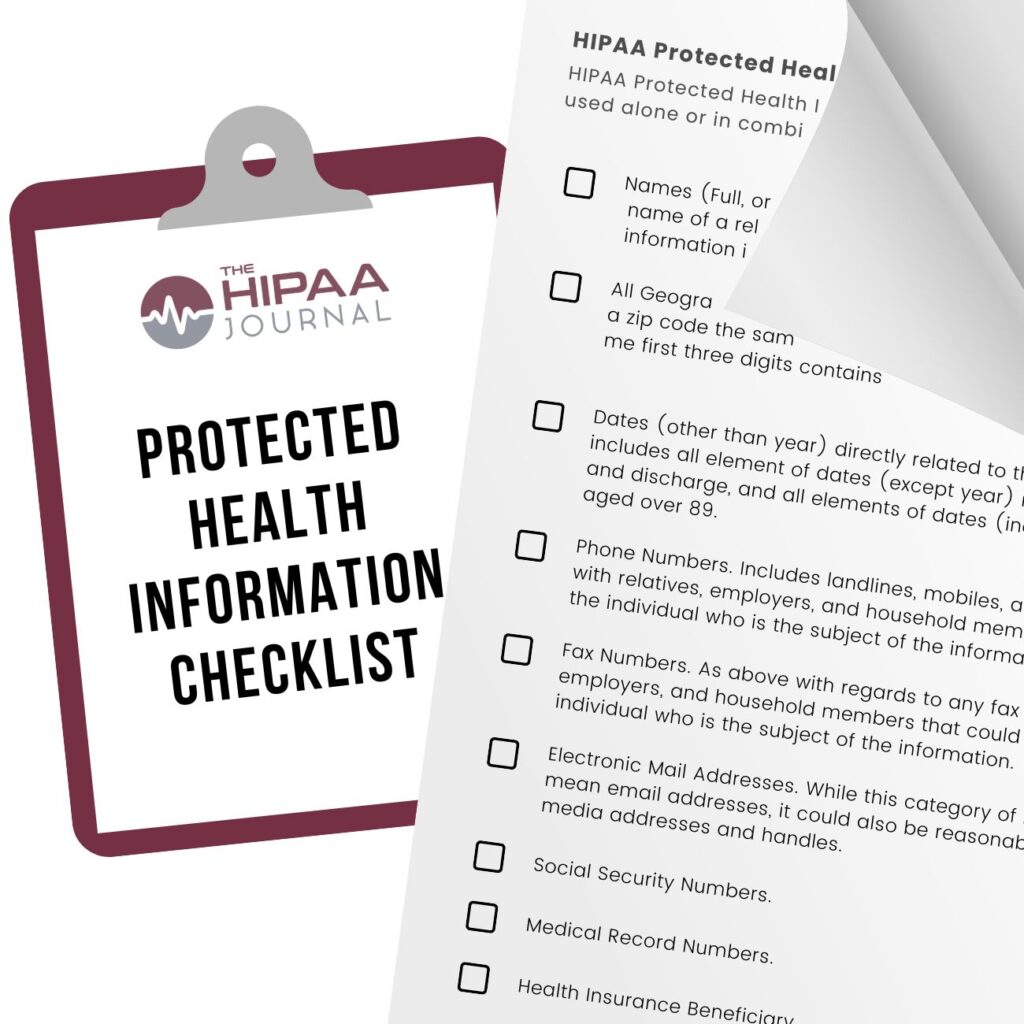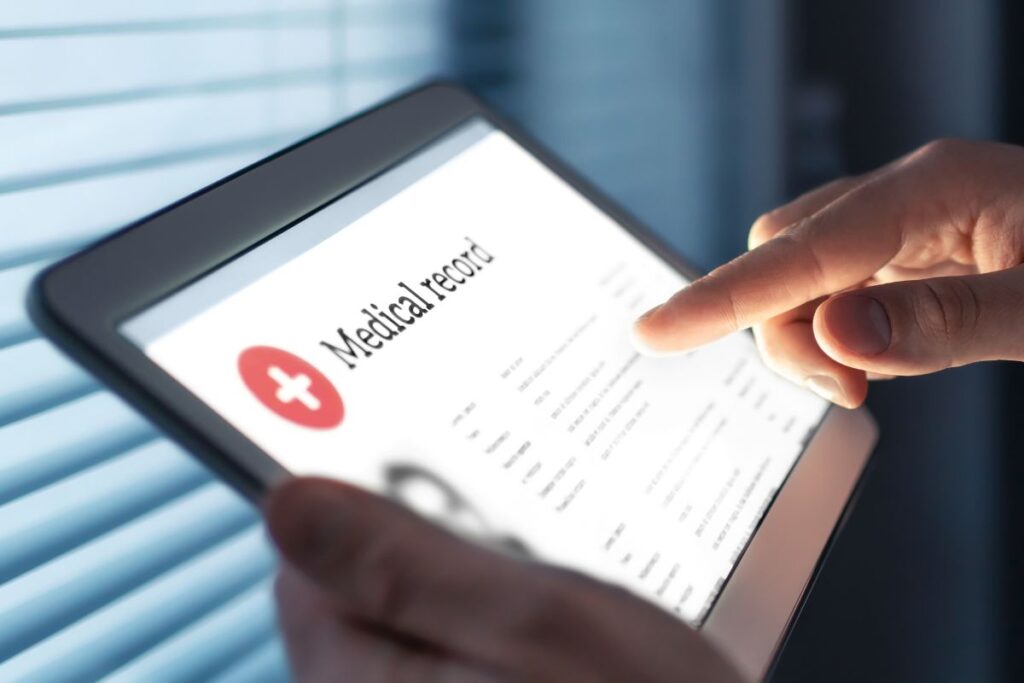De-identification of Protected Health Information: How to Anonymize PHI
Healthcare organizations and their business associates that want to share protected health information (PHI) in a HIPAA-compliant way must do so in accordance with the HIPAA Privacy Rule, which limits the possible uses and disclosures of PHI, whereas de-identification of PHI means HIPAA Privacy Rule restrictions no longer apply.
 You can use our free Protected Health Information Guide to learn how to de-identify and anonymize PHI. If you de-identify PHI so that the identity of individuals cannot be determined, and re-identification of individuals is not possible, PHI can be freely shared.
You can use our free Protected Health Information Guide to learn how to de-identify and anonymize PHI. If you de-identify PHI so that the identity of individuals cannot be determined, and re-identification of individuals is not possible, PHI can be freely shared.
HIPAA Privacy Rule restrictions only covers individually identifiable protected health information. The de-identification of protected health information enables HIPAA covered entities to share health data for large-scale medical research studies, policy assessments, comparative effectiveness studies, and other studies and assessments without violating the privacy of patients or requiring authorizations to be obtained from each patient prior to data being disclosed.
HIPAA-Compliant De-identification of Protected Health Information
HIPAA-compliant de-identification of protected health information is possible using two methods: Safe Harbor and Expert Determination.
Neither method of de-identification of protected health information will remove all risk of re-identification of patients, but both methods will reduce risk to a very low and acceptable level.

Learn How To Safeguard Your Protected Health Information
Order Our Free Protected Health Information Guide & Checklist
(download link sent by email)
Please enter correct email address
Your Privacy Respected
HIPAA Journal Privacy Policy
Use either of the two methods below and PHI will no longer be considered ‘protected health information’ and not be subject to HIPAA Privacy Rule restrictions.
1. Safe Harbor – The Removal of Specific Identifiers
 The first HIPAA compliant way to de-identify protected health information is to remove specific identifiers from the data set. The identifiable data that must be removed according to 45 CFR §164.514(b)(2) are:
The first HIPAA compliant way to de-identify protected health information is to remove specific identifiers from the data set. The identifiable data that must be removed according to 45 CFR §164.514(b)(2) are:
- Names
- Geographic subdivisions smaller than a state
- All elements of dates (except year) related to an individual (including admission and discharge dates, birthdate, date of death, all ages over 89 years old, and elements of dates (including year) that are indicative of age)
- Telephone, cellphone, and fax numbers
- Email addresses
- IP addresses
- Social Security numbers
- Medical record numbers
- Health plan beneficiary numbers
- Device identifiers and serial numbers
- Certificate/license numbers
- Account numbers
- Vehicle identifiers and serial numbers including license plates
- Website URLs
- Full face photos and comparable images
- Biometric identifiers (including finger and voice prints)
- Any unique identifying numbers, characteristics or codes
In the case of zip codes, covered entities are permitted to use the first three digits provided the geographic unit formed by combining those first three digits contains more than 20,000 individuals. When that geographical unit contains fewer than 20,000 individuals it should be changed to 000. According to the Bureau of the Census, that means 17 zip codes must have the first three digits changed to zero:
036, 692, 878, 059, 790, 879, 063, 821, 884, 102, 823, 890, 203, 830, 893, 556, 831
Covered entities should not that the above list of zip codes may change after future censuses. The list is based on 5-digit zip codes from the 2000 census.
IMPORTANT NOTE: The list of HIPAA identifiers was compiled in 1999 and is now out-of-date. Additional identifiers that must be removed from a designated record set before it can be considered de-identified include social media aliases, Medicare Beneficiary Numbers, and details relating to an emotional support animal if the animal could be used to identify the subject of the PHI.

Learn How To Safeguard Your Protected Health Information
Order Our Free Protected Health Information Guide & Checklist
(download link sent by email)
Please enter correct email address
Your Privacy Respected
HIPAA Journal Privacy Policy
2. Expert Determination
 The expert determination method carries a small risk that an individual could be identified, although the risk is so low that it meets HIPAA Privacy Rule requirements.
The expert determination method carries a small risk that an individual could be identified, although the risk is so low that it meets HIPAA Privacy Rule requirements.
This method of de-identification of protected health information requires a HIPAA covered entity or business associate to obtain an opinion from a qualified statistical expert that the risk of re-identifying an individual from the data set is very small. In such cases, the methods used to make that determination and justification of the expert’s opinion must be documented and retained by the covered entity or business associate and made available to regulators in the event of an audit or investigation.
The expert must be a person with appropriate knowledge and experience of using generally accepted statistical and scientific principles and methods for removing or altering information to ensure that it is no longer individually identifiable.
When those methods and principles have been applied, the expert must determine that the risk of reidentification of an individual is very small. In such cases, the risk of reidentification must be very small when the information is used alone, and must remain very small should the data be combined with other reasonably available information by an anticipated recipient to identify an individual who is a subject of the information.
HIPAA does not define the level of risk of re-identification other than to say it should be ‘very small’. The expert should define ‘very small’ in relation to the context of the data set, the specific environment, and the ability of an anticipated recipient to be able to reidentify individuals.
Experts may come from a number of different fields and do not require any specific qualifications. What is important is experts have experience of deidentifying data. It is that experience that regulators will look at in the event of an audit, not specific qualifications or certifications.
For further information on de-identification of protected health information by expert determination see 45 CFR § 164.514(b)(1).
The U.S. Department of Health and Human Services’ Office for Civil Rights has issued guidance on de-identification of protected health information which can be viewed on this link.

Learn How To Safeguard Your Protected Health Information
Order Our Free Protected Health Information Guide & Checklist
(download link sent by email)
Please enter correct email address
Your Privacy Respected
HIPAA Journal Privacy Policy
De-identification of Protected Health Information FAQs
Why is the list of Safe Harbor identifiers the same as many definitions of PHI?
The list of Safe Harbor identifiers is the same as many definitions of PHI because some sources have mistakenly used the list to answer the question “what is PHI?” It is important to be aware this is not the case.
PHI – or Protected Health Information – is individually identifiable health information that relates to an individual’s past, present, or future health condition, treatment for the condition, or payment for the treatment. Only when identifiers are maintained in the same designated record set as PHI do the identifiers assume protected status.
The list of Safe Harbor identifiers is a (now incomplete) list of possible identifiers that could be maintained in the same designated record set as PHI. If so, they (and any other identifiers not included on the list) must be removed from the designated record set before any remaining PHI is considered de-identified.
Do doctors´ names have to be removed from a data set for PHI to be de-identified?
Doctors’ names have to be removed from a data set for PHI to be de-identified if the name of a doctor – individually or with other information – could be used to identify the subject of the data set. If there is very little chance of a patient being identified by a doctor´s name, then the name can remain in the de-identified data set subject to any state laws or confidentiality concerns.
Generally, with regards to the removal of names from designated data sets, the name of the patient (including nicknames, pet names, and any other names they may be known by) have to be removed, along with the names of relatives, employers, and household members. There is no requirement in HIPAA to remove the names of healthcare providers or any workforce members.
Must a Business Associate Agreement or Data Use Agreement be in place before disclosing de-identified health data to a business partner?
A Business Associate Agreement or Data Use Agreement does not have to be in place before disclosing de-identified health data to a business partner. However, covered entities can, if they wish, enter into a Data Use Agreement with the recipient of the data to specify how the recipient can use the data and prohibit its re-identification.
What is considered “appropriate knowledge and experience” for expert determination?
There is no definition of appropriate knowledge and experience for expert determination in HIPAA. However, in the event of a HIPAA compliance audit, the Department of Health & Human Services´ Office for Civil Rights would review the expert´s professional experience and academic training of the expert, and the processes used in the de-identification of the data set to assess their capabilities.
Is there an expiration date for de-identified health data?
There is no expiration date for de-identified health data stipulated in the Privacy Rule. However, the Department for Health & Human Services recognizes that “technology, social conditions, and the availability of information changes over time” and has suggested that covered entities periodically review the chosen de-identification method to ensure it meets the very low risk requirement.
Why is the list of Safe Harbor identifiers incomplete?
The list of Safe Harbor identifiers is incomplete because it was published quarter of a century ago in a time before (for example) social media and emotional support animals. If a patient has a social media handle maintained with PHI in a designated record set – or information relating to an emotional support animal – that information also needs to be removed from a designated record set before it can be considered de-identified.
What is the benefit of de-identifying Protected Health Information?
The benefit of de-identifying Protected Health Information is that the de-identified data can be used for medical research studies, policy assessments, comparative effectiveness studies, and other studies and assessments without violating patient privacy or requiring individual authorizations. Effectively, one PHI is de-identified, the restrictions of the Privacy Rule no longer apply.
What are the two HIPAA-compliant methods for de-identifying PHI?
The two HIPAA-compliant methods of de-identifying PHI are the Safe Harbor method and the Expert Determination method. It is important to be aware that the list of identifiers listed in the Safe Harbor method is out of date, and organizations considering this method of de-identification are advised to seek professional compliance advice before relying on the content of §164.514 to de-identify PHI.
How does the Expert Determination method of de-identifying PHI work?
The Expert Determination method of de-identifying PHI works by obtaining an opinion from a qualified statistical expert indicating that the risk of re-identifying an individual from the de-identified data set is very small. The methods used for this determination and justification of the expert’s opinion must be documented and retained by the covered entity or business associate.
Does the Privacy Rule define the level of risk of re-identification in the Expert Determination method?
The Privacy Rule does not define the level of risk of re-identification in the Expert Determination method other that stating it should be “very small”. This means the expert is required to define “very small” in relation to the context of the data set, the specific environment, what the data set will be used for, and the recipient’s reasonably anticipated ability to reidentify individuals.

Learn How To Safeguard Your Protected Health Information
Order Our Free Protected Health Information Guide & Checklist
(download link sent by email)
Please enter correct email address
Your Privacy Respected
HIPAA Journal Privacy Policy

De-identification Of Your Protected Health Information
Learn How to Anonymize PHI With Our Free Protected Health Information Guide & Checklist
(download link sent by email)
Please enter correct email address
Your Privacy Respected
HIPAA Journal Privacy Policy
HIPAA Journal featured on







